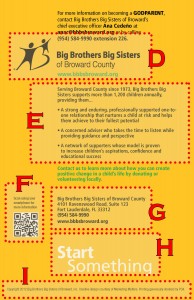Help Your Brochure Endure

How often are you handed a brochure for a company that you know absolutely nothing about? We’ve all been there. We’ve attended the walk-a-thons, seminars and sporting events that are enough of an assembly of like-minded people that local businesses, salivating at the captive audience, find their way in armed with a treasure trove of printed promotions. You take them, begrudgingly or not, and find that they resemble everything from popular office software templates to bulleted lists as extensive as the day is long.
These poor print-outs need help. Some of them struggle to stand out in an environment that is already saturated and others are injured before they even exit the gate, destined to failure due to missing a vital piece of the puzzle.
It doesn’t have to be that way. You can be a star producer who gives voice to the voiceless and lets the brochure sing all the details of your organization without always needing to be there to fill in the missing notes.
Help your brochure endure by following a few accepted and honed best practices.


Featured above is an annotated brochure that was originally produced for the “Godparent Journey,” a community engagement and fundraising project of Big Brothers Big Sisters of Broward County. Big Brothers Big Sisters, the nation’s largest donor and volunteer supported mentoring network, carefully pairs children (“Littles”) in need of a role model with screened volunteer mentors (“Bigs”) to create enduring matches that help children achieve in the face of adversity. Using this example, the following suggestions highlight elements that any great brochure should consider including.
A) Catchy tagline
Imagine for a moment that you know nothing about your business. What could you say quickly and generally that would pique most people’s interest. Lure the casual passerby with an intriguing tidbit. Try varying degrees of boldness or cleverness to see what works for your target audience.
B) Clear illustration of benefit
There is a sweet science to print marketing. To use a boxing metaphor, great visuals are the cross that follows your tagline’s jab in the one-two combination that draws your audience in and will have your competition on the ropes. If you gave the brochure to a ten year old, would the imagery be visually interesting, applicable and clear enough that they would be able to articulate what it is that you do?
C) Call to action
Tell people what you want from them. Maybe it is more important to your bottom line to have people register for your newsletter so you can keep in touch with them regularly. Perhaps you offer the kind of good or service that most people research at length and “Buy Today!” isn’t as effective as “Come visit us for a free trial.”
D) Corporate logo
Your logo is the first thing that people recognize as they move between your brochure, website, Facebook page and various other communication tools. Make it prominent and ever-present.
E) Boilerplate message
As a representative of your business, you should always have your pitch in mind. What will I tell a customer who has 5 minutes to dedicate? What if I only have 15 seconds of their time? Being concise is key. Fun fact: it’s called a boilerplate because text meant for widespread production used to require a heavy cast metal plate, like those found on boilers, that could stand up to heavy use. Make yours strong and succinct, not one word too many.
F) QR code
As has always been the case, the more time goes by from when your business is a fresh thought in someone’s mind, the less likelihood that they will act on it. Popular QR technology can produce a unique code that, when scanned by a smart phone, directs the user to the chosen custom link. Depending on the call to action, being able to quickly scan and find out more information may make the difference between capitalizing on temporary interest and a short attention span that just cost you a sale.
G) Contact information
“I like to call and talk to someone.”
“Well I usually go into the store and see for myself.”
“You’re both wrong. It’s the new millennium, everything is online now.”
Give them the details they need to find you using the method they prefer.
H) Branding standards
Whether you are part of a national chain or have a business accreditation, proudly displaying campaign language is beneficial to aid in recognition. Aside from being required in some circumstances, listing prominent branding can also serve to legitimize your organization, providing another familiar phrase or visual cue.
I) Copyright or trademark
Your concepts and creations are just as unique and valuable as your business model and they merit the same protection. By noting a copyright on your original written and printed work, you are laying claim and reserving the right to protect the contents as your own intellectual property. No one else should have the ability to copy or profit from your ideas without your express permission, and this notice protects you. There is no reason not to include it in the fine print. While you’re thinking about it, protect any registered trademarks as well.
Keep this best practice advice in mind for your original printed works and they stand a much greater chance of enduring in the commercial and digital world to stand out prominently and speak effectively about your organization when you can’t always be there personally.
_____________________________
Eric Lachs is the Marketing and Public Relations Manager at Marketing Matters (www.marketingmatters.net), a communications and design firm specializing in technology, consumer and custom electronics, audio-video and related industries.


 Your email will never be shared with a third party.
Your email will never be shared with a third party.